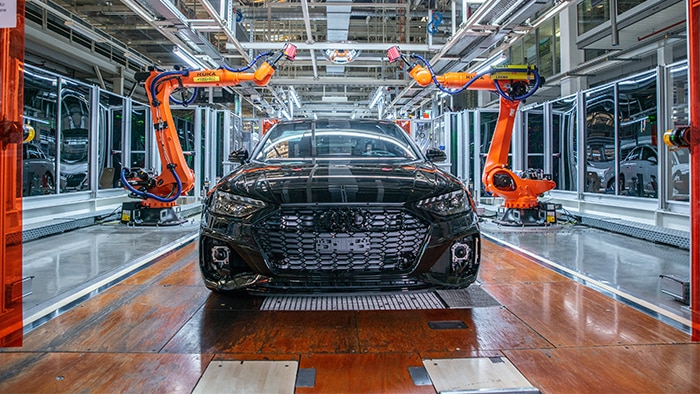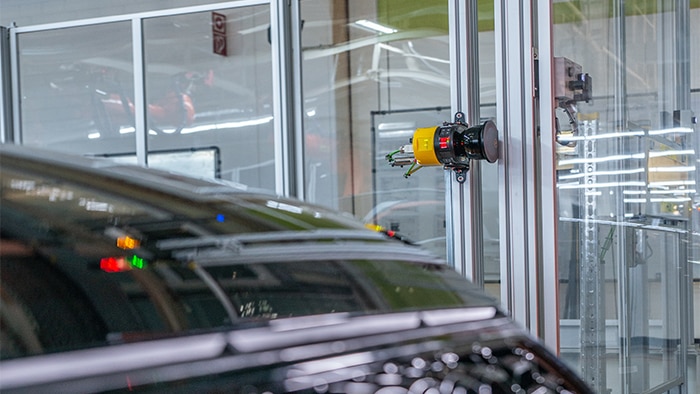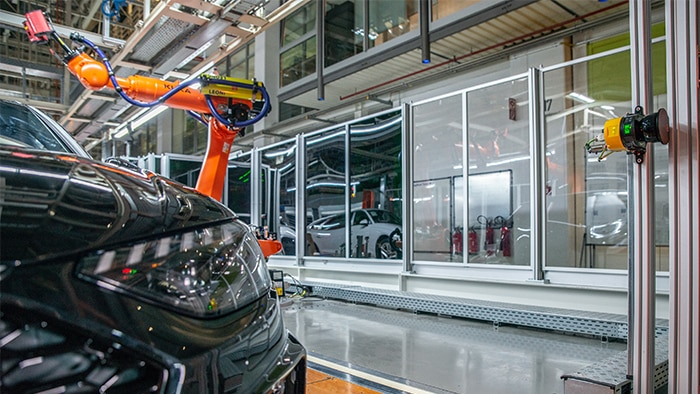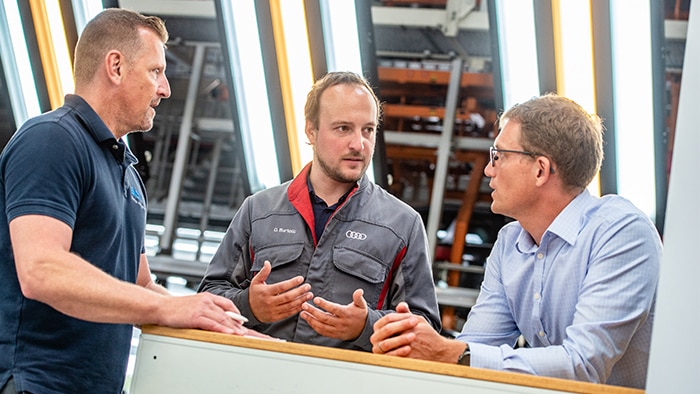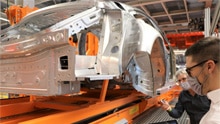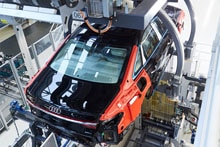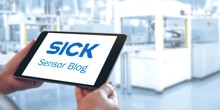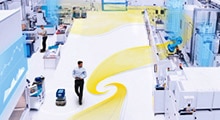The aim was to implement an access protection solution on a newly developed inline measurement cell at Audi that does not require muting sensors but can still handle all of the complex vehicle geometries. A challenging task that a team mastered with flying colors.
Safe access points, high flexibility, and a lean solution Safe Portal systems in the final assembly area at Audi
In the giant manufacturing hall at the headquarters of AUDI AG in Ingolstadt, Tobias Hacker, Technical Clerk in the Assembly Line Maintenance department at AUDI AG, and Martin Demharter, Key Account Manager Automotive Industry at SICK Vertriebs-GmbH are having a discussion right next to the final assembly line. They are both members of an interdisciplinary team from the manufacturing planning, plant engineering, and maintenance departments on the Audi side as well as the sales department and the technology division at SICK. They have been collaborating for several years now to guarantee the safety of the employees in the world's largest Audi factory while at the same time ensuring the material flow processes run smoothly.
Safe inline measurement cell for premium quality
All vehicle types that are manufactured in Ingolstadt pass through this hall for their final quality check, which includes checking for optimal gap dimensions. Employees previously performed the same thorough checks over and over again without electronic aids, which can pose quite a challenge for the human eye. After a transition phase to handheld measuring devices, this task is now performed by robots equipped with sensors that measure the gaps and flushness on the vehicle.
“We constructed the inline measurement cell to support in a sustainable manner not only the quality process with its measurement values but also the manufacturing process as a whole,” explains Daniel Bartolic, Specialist Planner in the Assembly Manufacturing Planning department and project manager. The vehicles travel on the final assembly line into the inline measurement cell and are inspected in regard to gaps and flushness in a matter of seconds by two robots operating concurrently. Access protection is provided by means of the Safe Portal system from SICK which utilizes the simultaneous protective field evaluation function of the microScan3 safety laser scanner. Two vertically aligned laser scanners at both the entry and exit of the inline measurement cell reliably and seamlessly protect the hazardous area through the intelligent evaluation of eight simultaneous protective fields.
The scanners use an infrared laser beam that is fanned out by means of a rotating mirror thereby creating a virtual protective field at the left and the right of the exit and entry point of the cell. A new TÜV-certified function block for the Siemens controller allows the simultaneous evaluation of both scanners. When a vehicle passes the suitably defined protective fields, the left and right scanners operating in unison recognize that it is a manufacturing material and not a person. The robots can therefore perform their inspection task as a hazardous situation has been excluded. Guaranteeing personal safety in this manner is the top priority at Audi when using large industrial robots.
Intelligent logic instead of rigid mechanical systems
Since several vehicle models with different geometries can be present on one and the same final assembly line in Audi’s Ingolstad factory, the requirements on a safe and at the same time productive solution for human-material differentiation are especially stringent. “We were looking for a safety solution that would suit all our existing vehicle models and configurations but would also allow us to implement new models as well,” explains Daniel Bartolic in regard to his initial requests to Martin Demharter at SICK. The new solution needed to be flexible, productive, cost-effective and in particular space-saving, and not require the use of safety gates or expensive muting sensors. Demharter discussed this demanding requirements scenario with the Strategic Product Planning department at SICK.
“We considered and investigated all safety-related perspectives and evaluated all relevant critical points with tests, trials and naturally the requisite comprehensive documentation,” summarizes Raphael Rotter, Strategic Product Manager at SICK regarding the extensive one-off effort that was invested in this and which paid off in the end: “We now have a lean solution that provides exactly the level of flexibility to also be able to cope with future developments in the final assembly area,” summarizes Daniel Bartolic regarding the outcome for Audi. The Safe Portal safety system is TÜV-certified, comprises two safety laser scanners and a function block for the Siemens S7 controller, and fulfills the requirements of EN ISO 13849. This standard solution in the SICK portfolio offers a flexible and efficient means of access protection in automotive production. As a bespoke development, it demonstrates how important the systems approach of combining hardware, software and services from a single source is.
More space, reduced complexity
For the maintenance engineer Tobias Hacker, the space savings and reduced complexity on the final assembly line is the decisive advantage: “The new compact solution dispenses with the previously used muting sensor – that saves up to a half a meter of space. We reduced the previously large number of variants of various hardware components such as photoelectric sensors and their cabling to just two scanners. This saves time and money on maintenance and repairs and we also benefit from the enormous reduction in complexity.”
Courage to blaze new trails in technology
This success story was made possible by the intensive and trusting collaboration within the team and, in particular, also the courage and preparedness of all those involved to blaze new trails. The in part deep black glossy surfaces of the car bodies really had the team stumped at the beginning because highly reflective surfaces are difficult for opto-electronic sensors to detect. The safety experts countered this problem with continuous improvements in the logic.
For example, the restart procedure after a detected protective field infringement was made consistent with the standard procedure for the factory so that black glossy car bodies can now also be reliably identified by the Safe Portal system. One and a half years after the project commenced, the Safe Portal system has just been commissioned on the second assembly line and is performing its task there unobtrusively and safely. There are several crucial factors that contributed to this success according to Martin Demharter: “Firstly the collaboration as equals, the long-standing cooperation between the companies, and most importantly the common desire to find the truly best technical solution is what led to the good outcome.”
The word has already got around at Audi about the positive experience with Safe Portal in the final assembly area because the people working in the car body construction area, the paint shop, and the press shop are also interested in technically mature, productive solutions for safe human-material differentiation. – Entirely consistent with the company’s primary motto: “Vorsprung durch Technik”.
Read more
Digital production and logistics: Audi’s Neckarsulm site lays further foundations for a fully connected factory
Efficient automotive production with RFID technology

